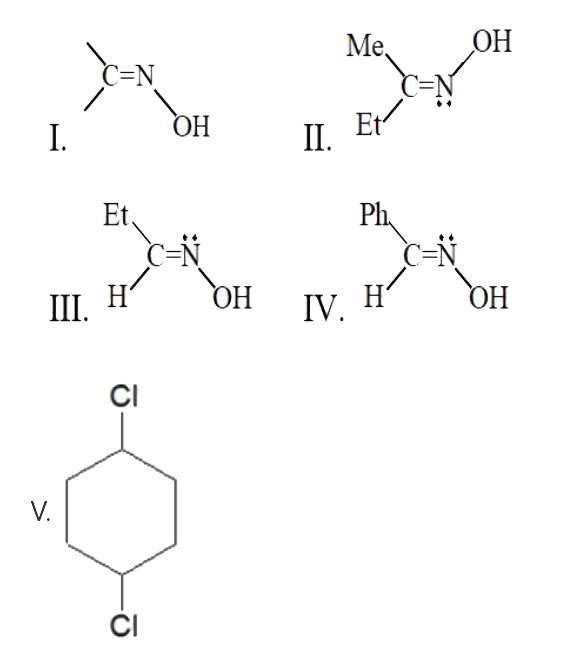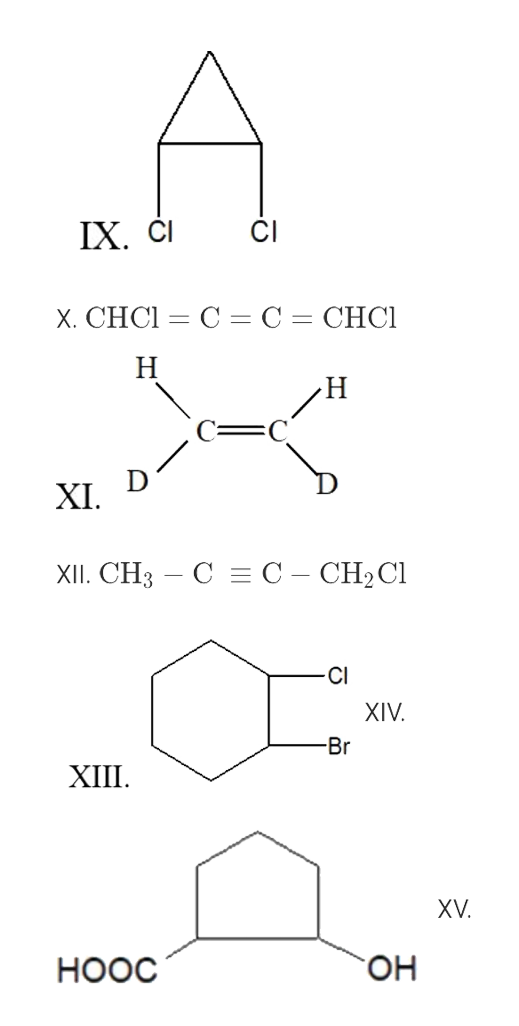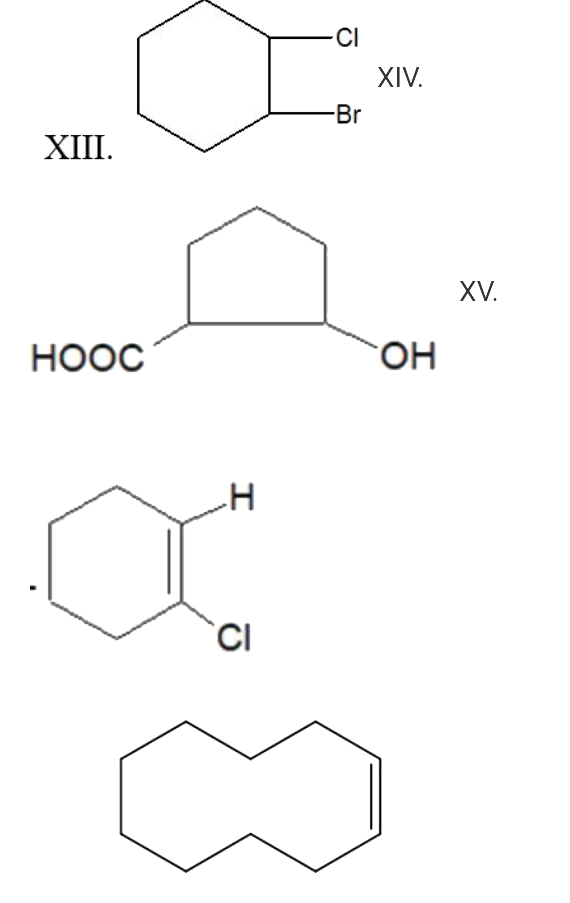Which of the following shows geometrical isomerism ?
(i)CHCl=CHCl , (ii)CH2=CCl2 , (iii) CCl2=CHCl
Give structures of its cis- and trans-forms.
To determine which of the given compounds shows geometrical isomerism, we need to analyze each compound based on the criteria for geometrical isomerism. The two main conditions for geometrical isomerism are:
1. There must be a double bond (C=C) or a restricted rotation (like in cyclic compounds).
2. Each carbon involved in the double bond must have two different groups attached to it.
Let's analyze each compound:
Step 1: Analyze Compound (i) CHCl=CHCl
- The structure is:
ClCl||H−C=C−H||HH
- Each carbon (C) has two identical groups (Cl and H) attached. Therefore, it does not meet the criteria for geometrical isomerism.
Step 2: Analyze Compound (ii) CH₂=CCl₂
- The structure is:
Cl|H2C=C|Cl
- The first carbon (C) has two hydrogens (H) and the second carbon (C) has two different groups (Cl and H). Thus, this compound can exhibit geometrical isomerism.
Step 3: Analyze Compound (iii) CCl₂=CHCl
- The structure is:
Cl|Cl−C=C|H
- The first carbon (C) has two identical groups (Cl and Cl), while the second carbon has two different groups (Cl and H). Therefore, this compound does not meet the criteria for geometrical isomerism.
Conclusion
Based on the analysis:
- Compound (ii) CH₂=CCl₂ shows geometrical isomerism.
Step 4: Draw the Structures of cis- and trans- Forms for CH₂=CCl₂
- Cis form: The two Cl atoms are on the same side.
Cl|H2C=C|H
- Trans form: The Cl atoms are on opposite sides.
Cl|H2C=C|Cl
Final Answer
- The compound that shows geometrical isomerism is (ii) CH₂=CCl₂. The structures of its cis- and trans- forms are as follows:
- Cis: Cl and H on the same side.
- Trans: Cl and H on opposite sides.
2. Each carbon involved in the double bond must have two different groups attached to it.
- The structure is:
ClCl||H−C=C−H||HH
- Each carbon (C) has two identical groups (Cl and H) attached. Therefore, it does not meet the criteria for geometrical isomerism.
- The structure is:
Cl|H2C=C|Cl
- The first carbon (C) has two hydrogens (H) and the second carbon (C) has two different groups (Cl and H). Thus, this compound can exhibit geometrical isomerism.
- The structure is:
Cl|Cl−C=C|H
- The first carbon (C) has two identical groups (Cl and Cl), while the second carbon has two different groups (Cl and H). Therefore, this compound does not meet the criteria for geometrical isomerism.
Based on the analysis:
- Compound (ii) CH₂=CCl₂ shows geometrical isomerism.
- Cis form: The two Cl atoms are on the same side.
Cl|H2C=C|H
Cl|H2C=C|Cl
- The compound that shows geometrical isomerism is (ii) CH₂=CCl₂. The structures of its cis- and trans- forms are as follows:
- Cis: Cl and H on the same side.
- Trans: Cl and H on opposite sides.
Topper's Solved these Questions
- HYDROCARBONSBook:PRADEEPChapter:HYDROCARBONSExercise:ADDITIONAL QUESTIONS (SHORT ANSWER QUESTIONS)
Explore 62 Videos
- HYDROCARBONSBook:PRADEEPChapter:HYDROCARBONSExercise:ADDITIONAL QUESTIONS (LONG ANSWER QUESTIONS)
Explore 11 Videos
- HYDROCARBONSBook:PRADEEPChapter:HYDROCARBONSExercise:NCERT EXEMPLAR PROBLEMS WITH ANSWERS, HINTS AND SOLUTIONS (LONG ANSWER QUESTIONS )
Explore 4 Videos
- EQUILIBRIUM IN PHYSICAL AND CHEMICAL PROCESSESBook:PRADEEPChapter:EQUILIBRIUM IN PHYSICAL AND CHEMICAL PROCESSESExercise:Competition Focus (Jee(Main and advanced)/Medical Entrance) VIII. ASSERTION - REASON TYPE QUESTIONS (TYPE - II)
Explore 10 Videos
- HYDROGEN Book:PRADEEPChapter:HYDROGEN Exercise:COMPETITION FOCUS (Assertion-Reason Type Questions) Type 2
Explore 15 Videos
Similar Questions
Knowledge Check
Which of the following alkanes can exhibit cis-trans isomerism?
(i) CH2=CHCH2CH3 , (ii) CH2=C(CH3)2
(iii) CH3CH=CHCH3 , (iv) CH3CH2CH=CHClA(1) (i), (ii)B(2) (ii), (iii)C(3) (iii), (iv)D(4) (i), (iv)Which of the following compounds show optical isomerism ?
(a) Cis - [Co(NH3)4Cl2]+
(b) trans - [Co(en)2Cl2]+
(c ) cis - [Co(en)2Cl2]+
(d) [Co(en)3]3+Aa & bBb & cCc & dDa, b & dConsider the following halogen containing compounds
(i) CHCl3 (ii) CCl4
(iii) CH2Cl2 (iv) CH3Cl

The compounds with a net zero dipole moment areA(ii) and (v) onlyB(ii) onlyC(iii) and (iv) onlyD(i) and (ii) only
Which one of the following has the highest dipole moment ?
(i)CH2Cl2 (ii)CHCl3 (iii)CCl4.
View SolutionHow many of the following can show geometrical isomerism

VI. CHCl=C=CHCl
VII. pH−N=N−Ph
VIII. MeCH=N−NH2


View SolutionWhich of the following moleules have electric dipoles ?
(i)CCl4(ii)CHCl3(iii)CH2Cl2(iv)CH3Cl(v)CH4
View SolutionCH2Cl−CHCl2
View SolutionWhich of the following compounds will show cis-trans isomerism?
(i) (CH3)2C=CH−C2H5
(ii) CH2=CBr2
(iii) C6H5CH=CH−CH3
CH3CH=CClCH3
View Solution

